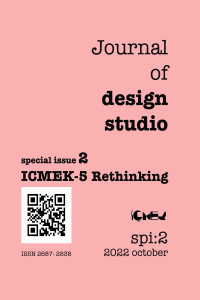Dialogical Structure Experience in Basic Design Studio at Online Education
Dialogical Structure Experience in Basic Design Studio at Online Education
Basic Design Studio, Face-to-face Education, Onilne Education, Dialogic COVID-19 Pandemic,
___
- Adıgüzel Özbek, D., (2020), Elective Courses as a Dialogic Environment: Sustainable Design in Interior Architecture Course. A+Arch Design International Journal of Architecture and Design (6)2, 75-91. Retrieved from https://dergipark.org.tr/tr/download/article-file/1374088
- Alexander, R.J. (2018). Developing Dialogue: Genesis, Process, Trial. Research Papers in Education, 33(5), 561-598. Retrieved from http://robinalexander.org.uk/wp-content/uploads/2019/12/RPIE-2018-Alexander-dialogic-teaching.pdf
- Fisher, R. (2007). Dialogic Teaching: Developing Thinking and Metacognition Through Philosophical Discussion. Early Child Development and Care, 177(6-7), 615-631.
- Ozkar, M. ve Steino, N. (2012). Shaping Design Teaching: Exploring Form as An Agent İn Design Reasoning and Pedagogy. In M. Özkar & N. Steino (Eds.), Shaping Design Teaching: Explorations İnto The Teaching of Form (pp. 9-24). Aalborg: Aalborg University Press.
- Reznitskaya, A. (2012). Dialogic Teaching Rethinking Language Use During Literature Discussions. The Reading Teacher, 65(7), 446–456.
- Sarıoğlu Erdoğdu, G. D. (2016). Temel Tasarım Eğitimi: Bir Ders Planı Örneği. Planlama 26(1), 7-19.
- Sözen, H. N. (2010). Sanata Disiplinlerarası Bir Yaklaşım: Enstalasyon Sanatı ve Genco Gülan Örneklemi. Sanat ve Tasarım Dergisi, 1 (6), 147-162. Retrieved from https://dergipark.org.tr/tr/pub/sanatvetasarim/issue/20661/220417
- Senel, S.A. (2014), Haritalama: Bir Anlama, Eleştirme ve Tasarlama Eylemi. In A. Şentürer, N. Paker, Ö. Berber, S.A., Şenel (Eds.), İstanbul İçin Öngörüler taarla – İTÜ MimariTasarım Araştırma Laboratuvarı Çalışmaları (pp.26-33). İstanbul: İTÜ Vakfı Yayınları.
- Senel, S.A. (2019), Mimarlık Eğitiminde Haritalama: Geleneksel Eril Mimarlık Üretimine Yaratıcı Bir Eleştiri, Dosya, no.42, 5-18.
- Yildiz, T. (2014). Diyaloji Diyalektiğe Karşı. Psikoloji Çalışmaları Dergisi 34-1 (pp.79-85)
- Yorgancıoğlu, D., Seyman Güray, T. (2018). Mimari Tasarım Eğitiminde Alternatif Yaklaşımlar: Bir Mekân Tasarımı Stratejisi Olarak “Parazit Mimari”. MEGARON 13(1) (pp.144-155), https://jag.journalagent.com/megaron/pdfs/MEGARON-74946-ARTICLE-YORGANCIOGLU.pdf
- Yüceer, D. (2020). Diyalojik Öğretim ve Ana Dili Eğitimi. Türkiye Sosyal Araştırmalar Dergisi, 24 (3), 701-712. Retrieved from https://dergipark.org.tr/tr/pub/tsadergisi/issue/58254/559836
- Yayın Aralığı: Yılda 2 Sayı
- Başlangıç: 2019
- Yayıncı: Orhan HACIHASANOĞLU
Zobo Tea Package Design Prototype Allied with Product Onomastics
Ayorinde OLUYEMİ, E. Bankole OLADUMİYE, Oluwafemi S. ADELABU
Rahman TAFAHOMİ, Reihaneh NADI
Bülent ÜNAL, Hatice Merve DEMİRCİ, Emrah DEMİRHAN
Hapticity in Digital Education Atmospheres
Esen Gökçe ÖZDAMAR, Gökçen Firdevs YÜCEL CAYMAZ, Hülya YAVAŞ
Dialogical Structure Experience in Basic Design Studio at Online Education
